Themed collection Nanoalloys: recent developments and future perspectives

Correction: In situ study of the evolution of FeNi nanocatalysts in reductive and oxidative environments upon thermal treatments
Faraday Discuss., 2023,242, 374-374
https://doi.org/10.1039/D2FD90077G
List of participants
Faraday Discuss., 2023,242, 549-551
https://doi.org/10.1039/D2FD90093A
Poster list
Faraday Discuss., 2023,242, 545-548
https://doi.org/10.1039/D2FD90092K
Correction: Interplay between interdiffusion and shape transformations in nanoalloys evolving from core–shell to intermixed structures
Faraday Discuss., 2023,242, 69-69
https://doi.org/10.1039/D2FD90089K
Tuning the degree of CO2 activation by carbon doping Cun− (n = 3–10) clusters: an IR spectroscopic study
Carbon-doped anionic copper clusters exhibit a size- and dopant-loading dependent activity towards CO2, resulting in activation and dissociation.
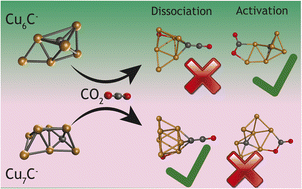
Faraday Discuss., 2023,242, 252-268
https://doi.org/10.1039/D2FD00128D
Concluding remarks
The field of nanoalloys has evolved a lot since the first Faraday Discussions on this topic. These concluding remarks highlight these changes and try to extrapolate what future research directions might be.
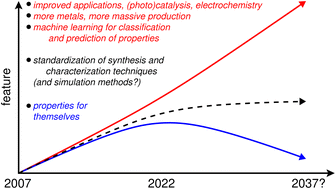
Faraday Discuss., 2023,242, 542-544
https://doi.org/10.1039/D2FD00139J
Joint electric and magnetic beam deflection experiments and quantum chemical studies of MSn12 clusters (M = Al, Ga, In): on the interplay of geometric structure and magnetic properties in nanoalloys
Cold MSn12 nanoalloy clusters (M = Al, Ga, In) have been studied in combined electric and magnetic beam deflection experiments. By a quantum chemical approach the correlation between geometric structure and magnetic properties has been elucidated.
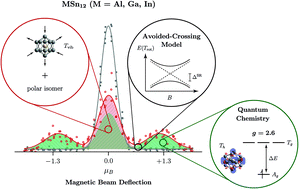
Faraday Discuss., 2023,242, 231-251
https://doi.org/10.1039/D2FD00091A
Oxidation and de-alloying of PtMn particle models: a computational investigation
We present a computational study of the energetics and mechanisms of oxidation of Pt–Mn systems.
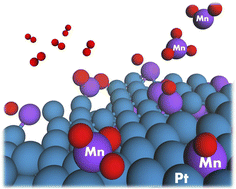
Faraday Discuss., 2023,242, 174-192
https://doi.org/10.1039/D2FD00107A
In situ study of the evolution of NiFe nanocatalysts in reductive and oxidative environments upon thermal treatments
XAS monitoring of the reduction of partially oxidized NiFe nanoparticles evidenced an internal redox phenomenon induced by a residual Ni core, before complete reduction occurred with a change in the chemical structure from core–shell to alloy.
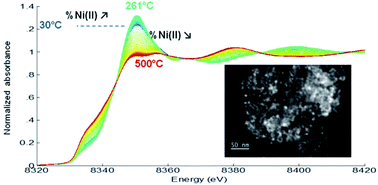
Faraday Discuss., 2023,242, 353-373
https://doi.org/10.1039/D2FD00095D
Spiers Memorial Lecture: Nanoalloys of multiple components; the road to advance the field and experimental and theoretical challenges
We look at nanoparticles with three or more metals and examine how they are stabilized by kinetic energy and the entropy of the system. The importance of twin boundaries in nanoalloys is discussed.
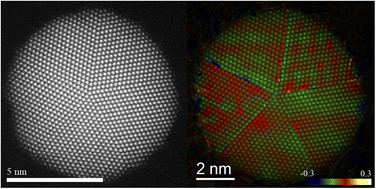
Faraday Discuss., 2023,242, 10-22
https://doi.org/10.1039/D2FD00137C
Plasmon-driven methanol oxidation on PtAg nanoalloys prepared by improved pulsed laser deposition
We proposed a general strategy for alloying silver and platinum elements into single-phase solid-solution nanoparticles with arbitrarily desired composition by bonding pure Pt targets with pure Ag strips in an improved pulsed laser deposition.
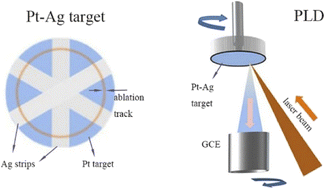
Faraday Discuss., 2023,242, 499-521
https://doi.org/10.1039/D2FD00102K
Disproportional surface segregation in ligand-free gold–silver alloy solid solution nanoparticles, and its implication for catalysis and biomedicine
This study provides novel insight into the surface chemistry of laser-ablated organic-ligand-free gold–silver alloy nanoparticles via extensive electrochemical characterization.
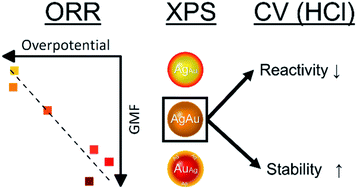
Faraday Discuss., 2023,242, 301-325
https://doi.org/10.1039/D2FD00092J
Oxidative dehydrogenation of cyclohexene on atomically precise subnanometer Cu4−nPdn (0 ≤ n ≤ 4) tetramer clusters: the effect of cluster composition and support on performance
High fidelity selectivity tuning of the oxidative dehydrogenation of cyclohexene was achieved through the control of the atomic composition of CuPd clusters and their interactions with the support.
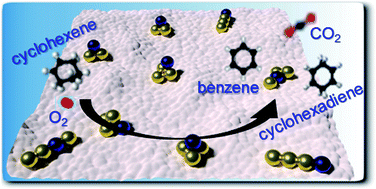
Faraday Discuss., 2023,242, 70-93
https://doi.org/10.1039/D2FD00108J
Synthesis and structural properties of high-entropy nanoalloys made by physical and chemical routes
Chemical and physical synthesis methods were developed to fabricate high entropy nanoalloys containing up to five metals. TEM was exploited to reveal size and compositional effects on the nanophase diagram of these complex nanostructures.
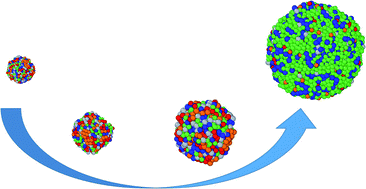
Faraday Discuss., 2023,242, 129-143
https://doi.org/10.1039/D2FD00118G
Density functional theory based computational investigations on the stability of highly active trimetallic PtPdCu nanoalloys for electrochemical oxygen reduction
The stability of highly active trimetallic PtPdCu nanoalloys for electrochemical oxygenation reduction is a result of closed-loop oscillation processes among dissolution, deposition, and Cu diffusions between the inner layers and the surface layer.
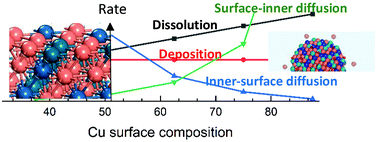
Faraday Discuss., 2023,242, 429-442
https://doi.org/10.1039/D2FD00101B
Doped metal clusters as bimetallic AuCo nanocatalysts: insights into structural dynamics and correlation with catalytic activity by in situ spectroscopy
Cobalt doping of Au25 nanoclusters led to an enhancement in the catalytic behaviour. The evolution of the doped Au clusters to nanoalloys with controlled surface sites was revealed by combined XAFS, DRIFTS and XPS studies.
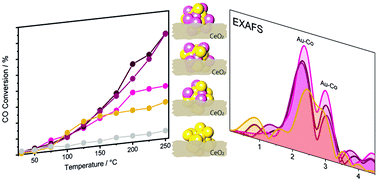
Faraday Discuss., 2023,242, 94-105
https://doi.org/10.1039/D2FD00120A
Cu segregation in Au–Cu nanoparticles exposed to hydrogen atmospheric pressure: how is fcc symmetry maintained?
The structure and dynamics of Au–Cu NPs exposed to hydrogen atmospheric pressure are studied, and the role of Cu in maintaining their fcc symmetry explored.
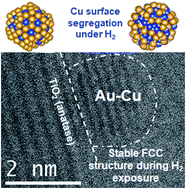
Faraday Discuss., 2023,242, 375-388
https://doi.org/10.1039/D2FD00130F
Mixed-metal nanoparticles: phase transitions and diffusion in Au–VO clusters
Nanoparticles with diameters in the range of a few nanometers, consisting of gold and vanadium oxide, are synthesized by sequential doping of cold helium droplets in a molecular beam apparatus and deposited on solid carbon substrates.
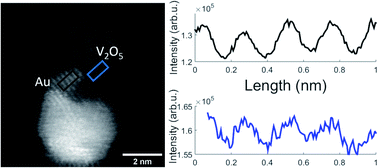
Faraday Discuss., 2023,242, 160-173
https://doi.org/10.1039/D2FD00089J
The role of the gold–platinum interface in AuPt/TiO2-catalyzed plasmon-induced reduction of CO2 with water
Photocatalytic evaluation of Janus and core–shell alloy nanostructures prepared by chemical reduction shows that the gold–platinum synergy for plasmon-induced methane artificial photosynthesis from CO2 and water is driven by the Au–Pt interface.

Faraday Discuss., 2023,242, 443-463
https://doi.org/10.1039/D2FD00094F
Structural characterisation of nanoalloys for (photo)catalytic applications with the Sapphire library
We present an open-source library, Sapphire, to classify the characteristics of nanoalloys through several structural analysis techniques. We focus on using geometrical descriptors to make predictions on a given nanoparticle's catalytic activity.

Faraday Discuss., 2023,242, 326-352
https://doi.org/10.1039/D2FD00097K
Isoprene selective hydrogenation using AgCu-promoted Pd nanoalloys
The addition of moderate amounts of Ag and Cu to Pd significantly enhances the isoamylene yield in isoprene hydrogenation. The surface Pd composition ratio between the metallic and oxidized states shows significant effects on the monoolefines yield.
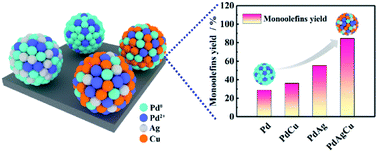
Faraday Discuss., 2023,242, 418-428
https://doi.org/10.1039/D2FD00074A
Structural and optical characterization of nanoalloys mixing gold or silver with aluminium or indium: evolution under various reactive environments
The atomic and chemical structure and the optical response of AxB1−x bimetallic nanoparticles (BNPs) combining gold or silver (A) with aluminium or indium (B) were investigated at various stoichiometries.
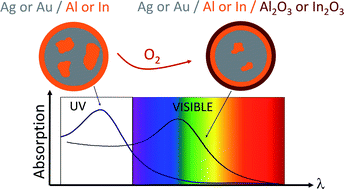
Faraday Discuss., 2023,242, 478-498
https://doi.org/10.1039/D2FD00109H
Methanol synthesis from CO2 and H2 using supported Pd alloy catalysts
We prepare a number of Pd based catalysts for the hydrogenation of CO2 to methanol, to explore Pd alloys under reaction conditions. HRTEM and EDX maps show element distribution for the PdZn/Ga2O3 catalyst.
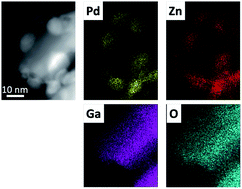
Faraday Discuss., 2023,242, 193-211
https://doi.org/10.1039/D2FD00119E
Interplay between interdiffusion and shape transformations in nanoalloys evolving from core–shell to intermixed structures
Molecular dynamics simulations allow us to identify the transformation pathways of AgAu, PtPd and AuCu nanoalloys from core–shell to intermixed configurations.
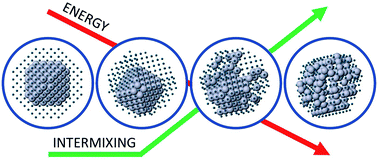
Faraday Discuss., 2023,242, 52-68
https://doi.org/10.1039/D2FD00113F
Characterization of Pt-doping effects on nanoparticle emission: a theoretical look at Au24Pt(SH)18 and Au24Pt(SC3H7)18
Au24Pt(SR)18 clusters have low-energy excited states with forbidden transitions and higher-energy excited states that undergo nonradiative transitions to lower-energy states.
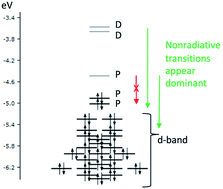
Faraday Discuss., 2023,242, 464-477
https://doi.org/10.1039/D2FD00110A
On the mechanical response in nanoalloys: the case of NiCo
Nanoindentation of spherical NiCo nanoalloys with core–shell & random mixing patterns was studied. We compared against monometallic nanoparticles to investigate how the mechanical response may be influenced by the elemental distribution & the proportion of each element.
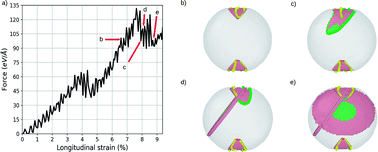
Faraday Discuss., 2023,242, 23-34
https://doi.org/10.1039/D2FD00111J
Melting properties of AgxPt1−x nanoparticles
At the nanoscale, materials exhibit unique properties that differ greatly from those of the bulk state. The melting systematically passes through an intermediate stage with a crystalline core and a pure liquid skin.
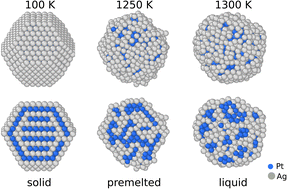
Faraday Discuss., 2023,242, 144-159
https://doi.org/10.1039/D2FD00116K
Combined atomistic simulations to explore metastability and substrate effects in Ag–Co nanoalloy systems
Combined experimental and simulation study on AgCo nanoalloys: (1) effect of amorphous carbon substrate: aspherical shape and orientational order; (2) kinetic effect due to atom-by-atom growth: growth of Co on Ag leads to subsurface clusters.

Faraday Discuss., 2023,242, 35-51
https://doi.org/10.1039/D2FD00114D
Radiative cooling in silver and palladium doped gold clusters
The size-dependent influence of silver and palladium doping on the recurrent fluorescence of laser excited gold clusters, is investigated by a combination of mass spectrometry and quantum chemical calculations.
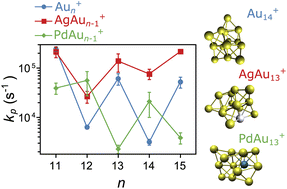
Faraday Discuss., 2023,242, 269-285
https://doi.org/10.1039/D2FD00090C
Structural evolution under physical and chemical stimuli of metastable Au–Fe nanoalloys obtained by laser ablation in liquid
Laser-generated Au–Fe alloy nanoparticles were exposed to thermal and chemical stimuli, showing that oxidation is crucial in determining phase and physical–chemical properties.
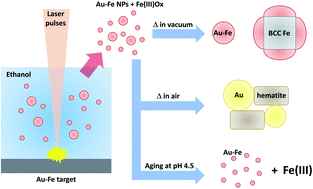
Faraday Discuss., 2023,242, 286-300
https://doi.org/10.1039/D2FD00087C
Nanoalloy magnetic and optical properties, applications and structures: general discussion
Faraday Discuss., 2023,242, 389-417
https://doi.org/10.1039/D2FD90087D
Nanoalloy structures and catalysis part 1: general discussion
Faraday Discuss., 2023,242, 106-128
https://doi.org/10.1039/D2FD90085H
Nanoalloy catalysis and magnetic and optical properties: general discussion
Faraday Discuss., 2023,242, 522-541
https://doi.org/10.1039/D2FD90088B
Nanoalloy structures and catalysis part 2: general discussion
Faraday Discuss., 2023,242, 212-230
https://doi.org/10.1039/D2FD90086F
About this collection
We are delighted to share with you a selection of the papers associated with a Faraday Discussion on Nanoalloys: recent developments and future perspectives. More information about the related event may be found here: http://rsc.li/nanoalloys-fd2022. Additional articles will be added to the collection as they are published. The final versions of all the articles presented and a record of the discussions will be published after the event.
In the field of nanoalloys many fundamental scientific questions and challenges remain. These include: the development of theoretical models to bridge ultrasmall clusters and large nanoparticles; the evolution from studying model catalysts to real catalysts under realistic operating conditions; developing thermally stable nanomagnets and nano-optic devices; controlling and tailoring nanoalloy formation processes in gas and liquid phases; determining transformation and ageing processes of nanoalloys in realistic environments; the structure and properties of tri-and multi-metallic nanoalloys. This meeting will cover 4 main themes: Nanoalloy structures, Nanoalloy catalysis, Magnetic and optical properties of nanoalloys and Applications of nanoalloys.
On behalf of the Scientific Committee, we hope you join us and participate in this exciting event, and that you enjoy these articles and the record of the discussion.